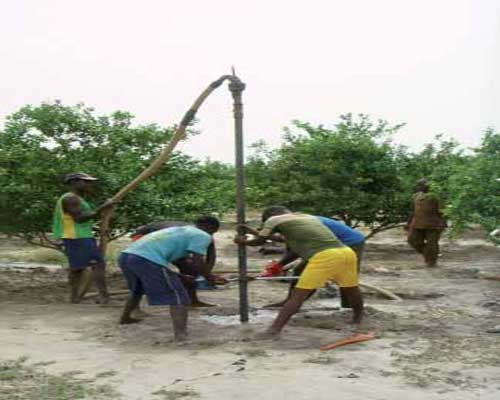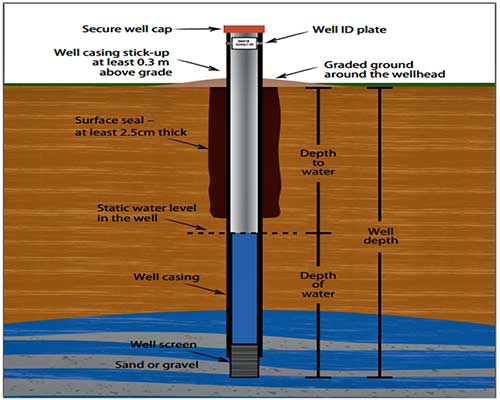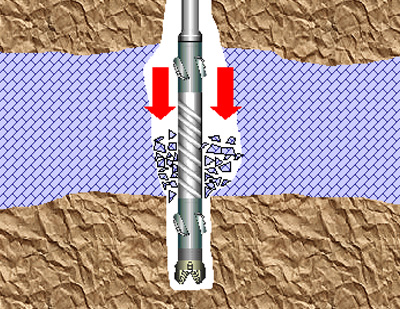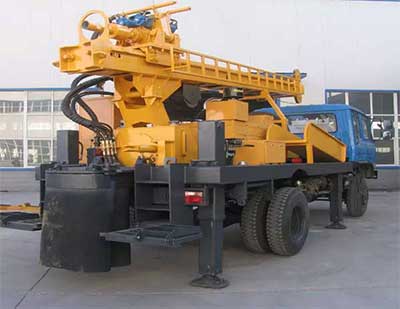Methods of drilling water boreholes
Once a borehole drilling has been decided and a suitable site selected, the proper drilling method must be chosen. Generally, drilling equipment consists of a mast from which the drilling components (tools, drill pipes and cable) are suspended and, in most cases the drill pipes are driven into the ground. It can be manual or powered driven method. The following are common methods of drilling for water:
A) Hand-auger drilling
The hang auger consists of extendable steel rods, rotated by a handle. A number of different steel augers (drill bits) can be attached at the end of the drill rods. The augers are rotated into the ground until they are filled, then lifted out of the borehole to be emptied. Above the water table, the borehole generally stays open without the need for support. Below the water table a temporary casing may be used to prevent borehole collapsing. Drilling continues inside the temporary casing using a bailer until the desired depth is reached. The permanent well casing is then installed and the temporary casing must be removed. Augers can be used up to a depth of about 15-25 meters, depending on the geology. Advantage: They are cheap equipment and easy to use above groundwater table; Disadvantage: It may be difficult to remove the temporary casing; Geological application: Limited to Sand, silt & soft clay.
B) Jetting
A method whereby water is pumped down a string of rods by motor water pump from which it emerges as a jet that cuts into the formation. Drilling may be aided by manually rotating the drill string or by moving it up and down in the hole. Cuttings are transported up by circulating water between the drill pipe and the borehole wall. The drill pipe may simply have an open end with a constructed drill bit added. Mud additives can be added to the water in order to prevent hole collapse and reduce loss of working water (drill fluid). Jetting (with rotation) can be used up to depths of 35-50 meters. Advantage: Drilling is very fast in sand; Disadvantage: A lot of working is needed at once; Geological application: Limited to sand and thin layers of soft clay.
C) Sludging
This method, which may be described as reverse jetting, involves a pipe being lowered into the hole and moved up and down with a lever arm. A one-way valve (such as someone’s hand at the top of the pipe) provides pumping action as water is fed into the hole and returns (with debris) up the drill pipe. There may be simple metal teeth at the cutting end of the pipe, and a small reservoir is required at the top of the hole for re-circulation. Mud additives can be added to the water to prevent hole collapse and reduce loss of working water (drill fluid). Sludging can be used up to depths of about 35 meters. Advantage: Easy to use and temporary casing is not needed; Disadvantage: Working water has to be maintained during the drilling process. The level of the water table is not known during drilling; Geological application: Sand, silt, clay, stiff clay and softer-consolidated rock formations (weathered laterite).
D) Manual Percussion drilling
MANUAL PERCUSSION uses a heavy cutting or hammering bit attached to a rope or cable and is lowered in the open bore hole or inside a temporary casing. Usually a tripod is used to support the tools. By moving the rope or cable up and down, the cutting or hammering bit loosens the soil or consolidated rock in the borehole, which is then extracted by using a bailer. Just as with hand augering, a temporary casing of steel or plastic may be used to prevent the hole from collapsing. When the permanent well screen and casing are installed, this temporary casing has to be removed. Manual percussion drilling is generally used up to depths of 25 meters. Advantage: Drills hard formations; Disadvantage: The equipment can be heavy and expensive. The method is slow, compared to other methods; Geological application: Sand, silt, stiff clays, sandstone, laterite, gravel and small stones.
E) Percussion drilling (Mechanical)
Mechanical winching obviously improves the effectiveness of percussion drilling (light cable tool rigs), and a number of useful choices are available. One example is the Forager 55 cable-trailer rig: weighing only 400 kilograms, it can be transported easily to inaccessible sites. The tripod frame can be erected by one person; and the heart of the system is a small free-fall winch, which hoists and drops the tool-set to drill the hole. Power can be provided either mechanically or hydraulically. However, this kind of rig is not adapted to hard formations or sediments containing blocks. In collapsible formations, the drilling depth is limited by the hauling capacity of the equipment used to retrieve the temporary casing that maintains the walls of the hole.
F) Heavy duty cable tool
Heavy-duty cable tool percussion drilling rigs are truck or trailer-mounted and powered by a large diesel engine driving a cable winch. To add extra weight and drilling power, a ‘sinker’ – or heavy solid steel bar – is fitted above the chisel- like cutting tool. This usually improves borehole straightness and verticality. Percussion rigs allow operators to vary the number of strokes per minute and the length of each stroke, to optimize penetration in hard or soft rock conditions. By adding water, cuttings are removed from a percussion-drilled borehole in the form of slurry and by means of a ‘bailer’ (heavy steel tube with a non-return ‘clack’ valve at the bottom). Softer, unstable formations such as sands or clays may require a combined hollow cutting and bailing tool.
G) Rotary drilling
Rotary drilling uses drilling mud (mixes of water, bentonite clays, polymers, and additives) as the circulation medium. In the rotary mud system, drilling fluid or mud is pumped down through the drill pipe and out through nozzles in the bit. As the bit penetrates the formation material, the drilling fluid circulates continuously and removes the cuttings. The fluid also serves to cool and lubricate the bit. The mud fluid then flows upwards in the annular space around the drill pipe to the surface, carrying the cuttings with it in suspension. At the surface, the drilling fluid is conditioned before being recirculated down the hole. Properly conditioning the mud helps to prevent down-hole problems.
The basic fluid normally used for rotary drilling is water, to which specific chemicals and other additives can be added to increase the density or viscosity to improve hole support. The fluid can also be weighted to control artesian pressures. The mud forms a membrane that inhibits flow through the walls of the hole, and the internal pressure of the mud provides structural support to the hole wall. The technique is useful for drilling operations in soft, unconsolidated formations and deep boreholes.
Talk to us for your upcoming project in Water Borehole Drilling
Geodata Evaluation & Drilling LTD. offers water borehole drilling services. Let us handle the project for you. contact us at www.geodatadrilling.com Phone: +234 8037055441




Please take attention to our company’s quality products and services as following, if you have interest in them:
(1) Diamond core drill rig, core drill rods, casing rods, wireline core barrel, diamond core bits, T.C. core bits, PDC drill bits, tricone bits, drag bits, mud pumps,and related drilling consumables;
(2) DTH drill rig, DTH hammers, DTH bits, DTH drill rods and relevant tools;
(3) Drill rigs, BOP, safety clamps, manual tongs, R.C hammers and bits, augers, water swivels, hoisting plugs, joint adapters, liners and pistons for mud pumps, and so on .
Dear Mr Chang Lin,
We have a plan to acquire additional drilling facilities. We will contact you in due course for the purchase of these facilities.
Thank you.